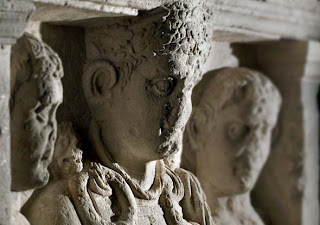For someone who died 2,000 years ago, we know rather a lot about Marcus Caelius.
He was born in Bologna in 44BC and rose through the ranks of the Roman army to the rank of senior centurion in the 18th Legion.
In 9AD he was based at Castra Vetera, near the modern-day German town of Xanten – which is around 12 miles from the airport of Weeze/Niederrhein and near the border with Holland.
Castra Vetera was a extensive military and administrative base, close to the river Rhine, and second only to Cologne in importance for the Roman Empire in the region.
Unlike Cologne, however, Castra Vetera, while it later expanded to become the thriving settlement of Colonia Ulpia Traiana, never developed into a modern city. Indeed, for that reason, Marcius Caelius would perhaps still be able to recognise its layout.
Unlike Cologne, however, Castra Vetera, while it later expanded to become the thriving settlement of Colonia Ulpia Traiana, never developed into a modern city. Indeed, for that reason, Marcius Caelius would perhaps still be able to recognise its layout.
His task would be made easier by the fact that the area is today the site of the Xanten Archaeological Park; where several Roman buildings have been recreated and where digs are still continuing to find out more about the region’s ancient past.
‘This was a very important strategic site,’ says Angelika Lucas-Thomas, one of the site’s highly informed and enthusiastic guides. ‘There were probably at least 10,000 people living here and the ancient city would have had a forum, three temples, an amphitheatre and large baths complex.’
Colonia Ulpia Traiana, like Cologne, Bonn and Mainz, were Rome’s frontier towns lying along the line of the river Rhine. ‘We think the harbour is still there, and well-preserved,’ adds Lucas-Thomas. ‘But it would cost around €30m to excavate, so that probably won’t be happening in the near future.’
Highlights of the park include a recreated hotel building, where archaeology students stay, the large harbour-temple and the amphitheatre, which could have accommodated more than 10,000 spectators.
Elsewhere, the lines of city walls, streets, houses and courtyards have been marked with hedges and trees – using species, such as planes and limes, that would have been known to the Roman inhabitants.
To discover more we walk through the site to the RömerMuseum, adjacent to the extensive remains of the city’s baths.
The museum, completed in 2008, helps breathe life into the site and its history. Modern, interactive and laid out simply and chronologically, it tells the tale of the place from its earliest days as a home of Germanic tribes, through to its glory days in the 2nd century AD, to its final decline and fall.
Visitors can try on a reconstructed Roman helmet and armour, feel the weight of a legionary’s equipment and sit on a four-pronged Roman saddle.
On the ground floor, we stop in front of Marcus Caelius’ gravestone. He is pictured in his full centurion’s uniform and flanked by two former slaves whom he freed.
There is perhaps nothing very surprising in that, but the inscription also tells us that that he met his end in what was possibly the greatest-ever defeat for the Roman army – the battle of the Teutoburg forest.
In 9AD over 18,000 troops left Castra Vetera and other nearby camps under the command of the governor of the Roman province of Germania, Publius Quinctilius Varus. They then headed west in search of rebellious tribes.
What they didn’t realise is that they were walking into a trap. In the depths of the forest, near modern-day Osnabrück, they were ambushed and annihilated over the course of a three-day battle.
Only a handful escaped alive. The veteran senior centurion Marcus Caelius wasn’t among them.

No comments:
Post a Comment